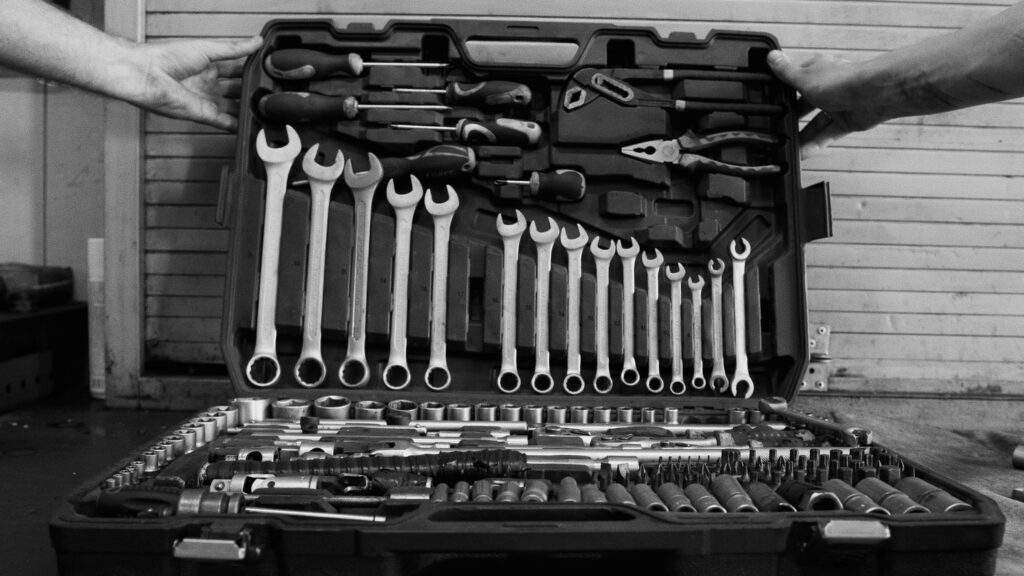Working on a Do-It-Yourself project requires more than detailed tutorials, free time, and will. How well you will do the job depends on the must-have tools for DIY to keep in your toolbox. Before you start planning your future handiwork, let’s see what you need to do it as flawlessly as possible.

1. Both types of screwdrivers
A well-equipped toolbox must include a screwdriver or a kit consisting of all sizes of this essential tool. Two types of screwdrivers are all you need to do repairs, assemble things, and even unhinge something. The first type is the Philips head characterized by a pointy top in the shape of a cross, while the second one is a Flathead screwdriver for screws that have an embedded line on the top.
If you have a small toolbox, we suggest you get a screwdriver handle with replaceable heads of all sizes. Also, opt for a rubber grip since it’s not slippery and uncomfortable to hold and maneuver in various positions.
2. A hammer to push and pull nails
Don’t go for a simple hammer, but invest a little more to get a claw-shaped one that can both push and pull a nail from the surface. A rubber handle will save you from calluses and pain in the wrist, as well as from slipping out of your hand and falling on your foot.
Hammers are not only for nailing things together. You can use them for demolition or disassembling, for example, walls and edge-joined wooden boards, respectively.
3. An adjustable wrench
A handy tool to have, an adjustable wrench has a moveable head that you can resize to match any bolt or nut. This is an important help to have when you have to fix the plumbing since you can also use it to tighten and loosen the pipe fittings. Since you will save money by buying this one and not the whole kit of wrenches, opt for the best alloy so it last longer.
4. Various shapes of pliers
When it comes to pliers, you have to decide which ones you will need the most since buying them all may take up all the space in your toolbox. For example, the basic ones you should have are flat or combination pliers that can pull things out, hold items, cut wires, and other things. Long-nose pliers for bending wires and diagonal pliers for cutting are also a good fit for a DIY toolkit.
Other ones you can include are tongue and groove pliers for turning nuts and bolts, linesman pliers for electrical work, and nail puller pliers to remove well-hammered nails. Additionally, buy pliers with rubber coating to avoid potential electrical shock if you plan to work with electricity.
5. A sturdy measuring tape and a spirit level
Chances are that you had a measuring tape in your home even before you bought a toolbox. This is the essential tool that every DIY project depends on, especially those where you build things from scratch. Look for the longest measuring tape with a stop system and nylon coating that will give it durability and sturdiness. Make sure that it shows both metric and imperial units. So you can easily follow tutorials from all sides of the world.
Another measuring tool, a spirit level will make sure that everything you make or assemble is properly aligned at a specific angle. It consists of a rectangular body with a small fluid vial in its centre with a bubble. This bubble will tell you whether something is straight or parallel to another surface, like a shelf to the floor.
6. A flashlight and spare batteries
Lighting your way during work around the house means you need to include a flashlight in your toolbox. Pick a model that throws bright and long light. So you can see even in the darkest corners. It is like under the house or when repairing the roof from inside the attic. To make sure that it’s always operational, buy a pack of batteries and keep them in the toolbox as well.
7. Basic safety gear
Safety gear is non-negotiable when it comes to any type of handwork, not just DIY projects. The minimum you need is goggles to protect the eyes from debris and gloves to protect your hands from injury. Mask, hat, and suit may seem like too much, but they will make sure you can do any type of work and stay safe. Choose fireproof materials, that will protect you from electric shock, and are not easily penetrated by sharp objects.
In conclusion
Besides these must-have tools for DIY to keep in your toolbox, you can also add a utility knife, chisel, handsaw, and other more specific equipment. But before you start buying everything from the shelves, it’s best to start with the basics and what you need for the current project. Once you get a grip on things, you can expand the toolkit to better fit your expertise.